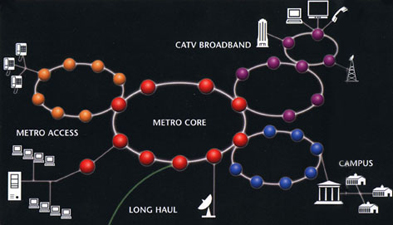Broadband fiber ain't what it used to be


There's a mythology out there, spread by the uninformed, that since 90 percent of broadband fiber is sitting in the ground and we getting exponentially better at sending massive amounts of bits through the air, that fiber's time has come and gone.
Not so. As the demand for rich broadband and high-definition television is increasing- some estimates place the growth at 70% a year- so has the carrying capacity for fiber. In fact, that carrying capacity is outpacing the growth in demand.
The not-so-secret sauce here is a technology called Dense Wave-Division Multiplexing, or DWDM for short. At the top of this post, that's a DWDM diagram from Multidyne Video & Fiberoptics Systems. The potential here is so robust, that folks like Telehouse America global account manager Robert Uhl calls DWDM "liquid bandwidth."
DWDM functions by splitting the use of a fiber into several different frequencies, which are represented by coolors of light. Each of these channels can, in turn, carry their own data traffic payloads.
For the specific concept, I cite from a fascinating article called "Out of Darkness." Written by Karen Brown and Tim Steinert-Threlkeld, it appears in the current issue of cable television trade weekly Multichannel News.
Up until this year, fiber providers have been able to subdivide their fiber strands into as much as 32 light channels each on long-haul routes. Each channel can carry up to 10 Gigabits of data per second. Network operators with smaller regional or metropolitan fibers typically light fiber with one wavelength per strand to 16 wavelengths, according to Fady Masoud, an optical product marketing manager at Nortel Networks Inc.
But the latest in fiber-optic technology from Nortel supports 72 light wavelengths on each fiber strand, and depending on the transmitters attached, each wavelength in turn can supply 2.5 Gb per second, 10 Gbps or 40 Gbps.
Given a fiber cable with 100 strands — a typical size for a long-haul route — and given that each strand is able to subdivide into 72 light wavelengths, carrying between 2.5 Gbps and 40 Gbps, that means total per-cable capacity is 18,000 Gbps to 288,000 Gbps.
In practical terms, that would allow between 909,000 and 14.5 million simultaneous HD streams to flow over a single fiber-optic cable.
Yes, but high-definition television, faster and faster broadband Internet, and Internet telephony, is this going to be a race between the increasing pace of fiber-optic capacity and the need for ever-speedier broadband carriage?
Well no, not really.
"The bottom line is that for now," Brown and Steinert-Threlkeld write, "the growth in existing capacity through fiber-optic technology improvements is outpacing the growth in overall bandwidth traffic, even with the tidal wave of high-definition TV, mobile broadband content, IP voice and video on demand now surging into the consumer market — and by extension, the intra-metropolitan traffic ..."
So not to worry, folks. We'll run out oil before we run out of fiber-optic cable.